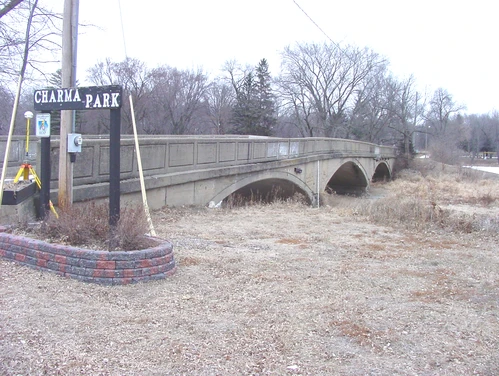- Year constructed: 1909
- Alternate name: Crane Creek Bridge
- Bridge type: Concrete Filled Spandrel Arch
- National Register of Historic Places status: Listed
- Length: 212 feet
- Width: 14 feet
- Spans: 3
- FHWA: 004265
- Jurisdiction: City of Dunkerton
- Location: Town Street over Crane Creek in Dunkerton, Section 29, T90N-R11W (Lester Township)
Details
The Dunkerton Bridge was once the main approach to the town of dunkerton from the north. although in its original location, traffic has been diverted from it and the bridge now carries pedestrian traffic between charma park to the north and marble street in downtown dunkerton. the park provides a bucolic setting for this picturesque structure. in april 1908, the black hawk county board of supervisors directed its bridge committee to investigate the possible construction of a bridge on a new road being built at dunkerton. according to county records, there had been a bridge built over crane creek at dunkerton in 1894 by the hannibal bridge company for $3,800. in july 1908, the committee reported that the "old bridge," perhaps the 1894 structure, could last another year or two with some repair work. when it came time for a new bridge, the committee recommended that it be constructed of steel and concrete and built at a different location than the old structure. the board authorized the bridge committee in january 1909 to secure plans and specifications for a new bridge. by april, the board advertised for competitive bids for either a concrete or steel structure. the contract was awarded to the marsh engineering company of des moines on may 8th. construction was underway in the summer and fall; the board accepted the bridge six months later, on november 8th. a bridge plate on the northwest corner of the span confirms that the bridge was designed and built by marsh in 1909, and lists the county supervisors for that year. marsh engineering was a prominent regional bridge firm known for concrete-arch bridge designs. the dunkerton bridge, a three-span, filled spandrel deck arch, has carried traffic in its urban setting with only minor repair-related alterations.
Before the re-formation of the state highway commission in 1913, the individual counties were responsible for bridge design and construction. They often relied on the bridge companies themselves or on in-state civil engineers for the designs. This is the case with the Dunkerton Bridge. Designed and built by one of Iowa's premier concrete bridge engineers, it is one of the few major concrete bridges remaining in the state that is still standing. For this reason it is noteworthy as an early example of urban arch bridge construction.
Adapted from Roise and Fraser 1992
Areas Served
- Black Hawk
